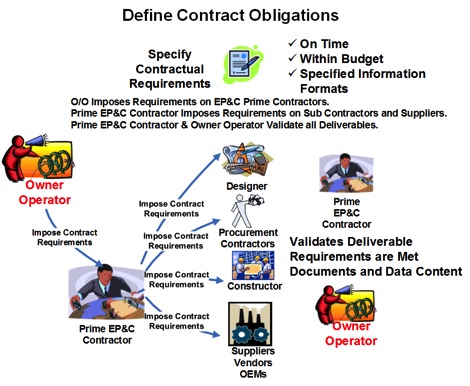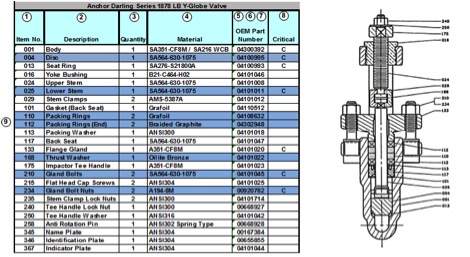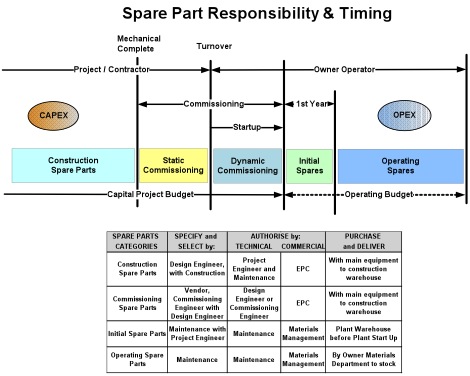David Lawton writes that with a few changes to capital project business processes and the implementation of a content management interoperability services (CMIS) database, operations content can be extracted directly from originating tools and populated into a data model that helps operations manage the lifecycle configuration. Consuming the project content during the project provides a vehicle to transform and feed subsequent processes.
On a typical new build process facility (this includes oil refining, oil and gas production, petrochemical, chemical, specialty chemical, and electric utility plants—whether they be hydro, fossil, or nuclear) it is possible to source equipment, materials, and spare parts from as many as five hundred unique suppliers. Each supplier will provide hard-copy document deliverables that are uniquely formatted. Extracting content from the suppliers represents a major task of the owner operator (O/O). Supplier deliverables consist of the information provided by the suppliers to support facility design and information to support the installation maintenance and operations of the equipment procured during the facility lifecycle. It is important for the O/O to clearly specify the deliverable requirements and formats and monitor that EPCs impose these requirements on their suppliers.
Over my career, I have worked at several utilities that continue to manage their spare parts using the numbering system that the engineering procurement construction (EPC) used to design the facility. Typically, EPCs create one design drawing for each component tag number. The drawing includes a bill of material that provides an item number for each of the components subassemblies and recommended spare parts.
In practice, maintenance will perform simultaneous repairs on multiple tagged components that share the same manufacture model number. This will require inventory replenishment on like spare parts, but due to the EPC numbering system the parts are uniquely identified by referencing original purchase orders, original drawing and drawing item number. This numbering system results in tremendous duplications in inventory, which drives up inventory costs and adds complexities to the supply chain management system. Unknowingly, the O/O could easily create multiple purchase orders line items that contain the same manufacture part number.
Suppliers pull the original purchase order drawing and convert the drawing item number to their standard manufacture part number and ship the part to the O/O; this fulfills the requirements of the new purchase order line item. After a little research, I uncovered that suppliers knowingly have provided different prices for the same manufacturer part number on the same purchase order.
Each facility has tens of thousands of components; these components are made up of hundreds of different manufacture model numbers. The same manufacture model numbers can occur multiple times within each facility.
One of the major utilities that I worked at had four separate nuclear facilities. The original equipment manufacturer (OEM), Limitorque, was common to all four units. There were over six hundred valve motor operators for the same manufacture model Limitorque SMB000. Each SMB000 contained approximately one hundred common spare parts of which twenty of these parts were unique to the overall gear ratio (combination of motor and worm drive gears). On average, roughly 80-85 percent of the parts were identical from one model to another with 15 percent being unique to the design. You can see that if the O/O does not manage the spare parts inventory by the lowest common denominator (manufacture part number), the resulting inventory duplications will unnecessarily drive up inventory values. In addition, spare parts identification can drive up the combinations of enterprise asset management (EAM) bills of materials, maintenance plans, and task lists.
Today’s engineering data management design systems can easily create one drawing for each manufacture model and reference the twenty or more respective component tag numbers with actual manufacture spare part numbers.
In a reactive maintenance culture, OPEX does not have the luxury of developing maintenance plans or equipment bills of materials for all of the facility components prior to operations. In reactive environments, unexpected failures set off a series of manual events. Systems engineers investigate the failure site to determine basic component design requirements necessary to put the facility back online. Warehouse personnel walked down the store rooms to locate availability of inventory. Supply chain management pulls the corresponding design drawings and procurement specifications to determine the requirements for procurement and prepare the purchase orders. Expediting airfreights the parts from the supplier. Maintenance planners have to develop the maintenance plans and procedures. It’s important to note that each manual step drives up the cost of doing business.
Reactive work management environments use a “where used” approach, in which workers add engineering, supply chain, and maintenance content to the appropriate systems after a failure has occurred.
The content found within the supplier documentation is critical to OPEX. EPCs, on the other hand, rarely use this information. This is why the EPC need to be aware of the importance of supplier content. Additionally, requirements need to be clearly identified in the EPC contracts along with the EPC responsibility in order to clearly spell out the supplier requirement in each purchase order.

Figure 1.This graphic identifies the accountability of the various parties in a facility new build.
Overall, very little supplier documentation is utilized by EPC’s to design, procure, or construct the facility. Detailed design engineering requests catalogs, drawings, equipment data sheets, failure mode and effects analysis (FMEA), performance curves, and equipment qualification (EQ) reports from suppliers manufacturers and distributors. This information is used to design and select the facility components. Construction utilizes OEM installation manuals to install the components. Commissioning consumes some spare parts to support dynamic system testing.
OPEX, on the other hand, relies heavily on supplier documentation to operate and maintain the facility. The maintenance manuals detail the sequence of equipment disassembly and maintenance procedures and EAM maintenance plans with task lists. The operations manuals are used to develop equipment-operating procedures.
One of the most critical supplier deliverables is the spare-parts bill of material. There are nine critical elements to a bill of material:
- Item number (relates item number and location as shown on OEM drawing)
- Item quantity (quantity required for each item)
- Item description (OEM description for selected item)
- Item material specification (material code or standard)
- Item OEM part number *1
- Item OPM part number *2
- Item supplier distributor part number
- Item criticality (indicates parts role in components ability to function)
- Item wear part indicator blue highlight (recommended spare part)
*1 Original equipment manufacturer (OEM) is a term that refers to a manufacturer that assembles multiple products into a final assembly that is sold directly from the manufacturer or by an authorized distributor. An example of an OEM are Limitorque manufacturers valve motor operators, which are assembled from parts that are manufactured by Limitorque.
*2 Original part manufacturer or OPM is a term that refers to the parts that are reassembled in the final product by the OEM. OEM purchase parts from OPM and resells them as their own using an OEM part number. An example of an OPM is a valve motor operator, which contains the following OPM parts: motors, bearings, seals, gaskets, and o-rings, which are procured by Limitorque from various OPMs and sold as Limitorque OEM spares.

Figure 2. Anchor Darling Globe Valve distributed by Flowserve. Note that the circled numbers align with the listing mentioned above.
Owner operators should consider requiring language in the EPC supplier purchase orders to specify a complete bill of material for all components with a reliability categorization critical and non-critical.
Recommended spare parts lists (RSPL) are one of the supplier deliverables. The Anchor Darling instruction manual for the globe valve above identifies the following recommended spares: packing rings (item numbers 110, 112), disc (item number 004), lower stem (item number 025), thrust washer (item number 168), gland bolts (item number 210), and gland bolt nuts (item number 234). The recommended quantity is one set of packing for every two valves of a particular type but not less than one set of each type. One complete set of the other parts is recommended for every ten valves of a particular type.
Within one facility the design may specify this valve in hundreds of different locations. RSPL recommendations do not take into consideration service conditions or duty cycles. By using the recommendations found within the manuals for two hundred valves, you can see how spare parts inventory can quickly climb out of control. There may be a better way to determine the spare part requirements for equipment.
Facility reliability analysis is normally an afterthought implemented by OPEX to improve facility uptime and reduce costs. Reliability analysis should begin during initial design to determine the systems function, component function, and separate individual components into categories critical non-critical and run to failure. System, components, connectivity, and the component class subclass obtained from the process and instrumentation diagram (P&ID) will be used to analyze component functions, function failures, failure severity, failure effect, failure mode, failure cause, and failure frequency. This analysis results in preventative maintenance (PM) tasks used in EAM maintenance plans. Reliability will review each valve individually to determine the service conditions (high temperature, humidity, radiation, contaminants) and duty cycles (24-by-7 operation, backup) of the specific valve design location. Once reliability has determined the valves failure modes, task lists are created for each failure type. The failure frequency should provide an accurate forecast of spare parts requirements.
Manufacturers rarely place all of the information required into a single parts list. O/O’s expend a considerable amount of work effort to locate and transform the information provided by the suppliers into digital content that can be consumed by maintenance systems. OPEX spends many hours searching through multiple supplier documents, performing individual part inspections, repeated communication with suppliers, distributors, and manufactures to obtain the necessary content.
Regarding the Anchor Darling globe valve figure above, numbers one, two, and three (item number, item description, and item quantity) were identified on the Anchor Darling globe valve drawing. Number four, the material specification, was identified on a separate Anchor Darling document along with the valves basic weights, valve ratings, and valve specifications. Number five, the OEM part numbers, could only be obtained after multiple communication efforts with Anchor Darling. Number six, the supplier distributor part numbers, were obtained after the original purchase order was identified and multiple communications with distributor. The OPM, number seven, was only identified after the equipment was disassembled and visually inspected. Number eight, the item criticality, was provided by OPEX procurement engineering analysis. Finally, number nine, the item wear as indicated by the blue highlighted rows, were extracted from the Anchor Darling instruction manual.
The O/O should consider clearly defining the spare part requirements, responsibility, and timing within the ECP contract.
Remember, spare parts are consumed throughout the facility lifecycle. Additionally, construction spare parts should be supplied with the equipment, and are the parts required to install and align the equipment. Construction spares include filter elements, seals, joints, bolts, gaskets, belts, packing, electrical fuses, cable, instrument tubing and fittings, and preservation fluids.
Commissioning spare parts, the parts required to enable uninterrupted installation and start-up of the equipment, should be supplied with the equipment. Commissioning spares include both equipment spares and dynamic commissioning spares or consumables. Equipment spares typically consist of filter elements, seals, joints, electrical and instrumentation components, calibration equipment, special tools, etc. Dynamic consumables typically consist of pipe, fittings, bolts, gaskets, electrical fuses, bulbs, cable, instrument tubing and fittings, lubricants, preservation fluids, chemical drying agents, etc.
The initial spare parts are those required to safeguard the operation of equipment during the running-in and starting-up and the first year of operation. Initial spare parts should be on site prior to start up. Initial spare parts overlap in some areas with commissioning spare parts and operating spare parts. They are required for the initial start-up and running-in and should cover the first year of operation. They consist typically of components such as bearings, mechanical seals, valves, instrument gauges, timers, filter elements; seal repair kits, gaskets, belts, electrical relays, electronic cards, fuel nozzles, etc.
The iperating spare parts are those required for normal operation and day-to-day maintenance in the two-year period following the initial operation period. Operating spare parts are those required for day-to-day maintenance after the initial year of operation. These parts may fail in use; there is no planned replacement interval and replacement is part of a corrective maintenance action or of an overhaul scheduled as a result of monitoring.
Capital insurance spare parts are high-value spare parts that would only be used in abnormal circumstances (major damage or failure). They may be components or complete units, such as complete pumps, large valves, motors, transformers, turbo-machinery cartridges, rotors, and heat exchanger tube bundles, etc. Due to their high value (and local tax regulations) there may be a financial advantage to the O/O to include them within the assets of the company. They are usually taken into stock against zero value. Capital insurance spare parts should be purchased simultaneously with the parent equipment, since this will be more economical and enable complete shop testing.

Figure 3. This graphic identifies the timing for the different spare parts categories: construction, commissioning, and operations.
Note that spare parts are paid out of different corporate budgets. The table determines which organizations specify the spare parts, authorize the purchase, and when the parts are delivered.
These practices will help facility owner operators to handle supplier deliverables in an efficient and effective way. With size and capital budget required, these best practices are essential to ensure the implementation of new facilities on time and within budget.

